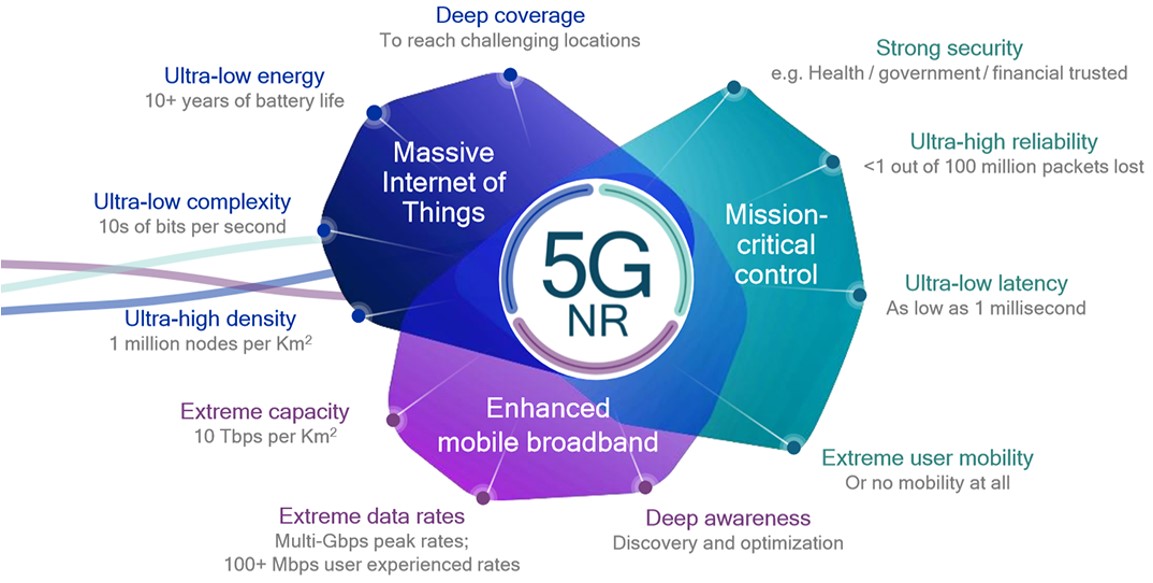Our interactions with MVNOs in the last 2 years have given us the sense that most MVNO view 5G as a step improvement over 4G (and the other Gs before that) hence have clear business opportunities for MVNO that are distinct from what hitherto been the case. In our experience, this is far from the case and a plethora of new opportunities abound. I will explore some of those opportunities.
The new opportunities that I will expound on are:
- Fixed wireless products opening a new market segment,
- 5G based IOT devices creating new opportunities for B2B MVNOs,
- MMC (Mini, Micro and Community operators), and
- Full service telecommunications operations using slicing capabilities of 5G
The figure below is from our whitepaper as adapted from Qualcomm showing the capability aspirations for 5G NR standards.

Some of the features that make 5G quite distinctive from prior standards are:
- Super Fast Speeds
- Ability to Effortlessly Slice the Network
- Super Efficient use of Spectrum
- End to End IP Signaling
So, having laid out the basics of 5G technology, we can explore the 4 opportunities identified in deeper detail.
Fixed Wireless Access.
Looks like a 4G FWA but with higher speeds on the face of it. But there is a twist to it. The fact that with 5G one is able to create super fast services with low latency creates an opportunity for MVNO that was not present. It creates a market where MVNO can attack the fiber market with a product that offers parity at worst and better. The low latency specification in the standards ensures that it out competes fiber in latency sensitive applications such as gaming and video streaming (Full disclosure, the author uses 5G services as a fiber replacement at the home office). And of course the 5G FWA is not prone to disruptions when there is construction going on in the neighborhood.
The cautionary tale for a potential MVNO in this segment is that they should not treat their customer as a traditional mobile customer but more like a fiber customer. The revenue profile for one is very different with a much higher ARPU from FWA and hence requiring a much more involved customer service, among others.
5G based IOT devices creating new opportunities for B2B MVNOs.
The standards call for massive IOT devices that have low power consumption, and high data throughput. With some of those devices being envisaged to run for up to 10 years without battery replacement, a whole range of opportunities open up. But unlike traditional MVNO retail business, the MVNOs in the IOT business would need to have corporate sales strategy and capabilities. Moreover, these MVNOs would need to create partnerships with the target customers that enhance their revenue potential using a range of business models. The opportunity here is that this is one field where the MVNOs are likely to compete on an even keel with the more resourced MNO due to their agility and specialist relations with the target customers.
Of course, the question is what is it that 5G IOT products can do that the previous iterations of telecommunications standards could not do. The answer is found in the technical capabilities of 5G standards. Low latency, low power consumption and high data throughputs. This means that applications such as smart cities, traffic control, power circuit monitoring are some of the applications that could be offered to the customers, secure in the knowledge that the technical capabilities are at hand.
MMC (Mini, Micro and Community operators).
It almost seems paradoxical that the most advanced interaction of GSM communication is the one able to profitably carry small MVNOs profitably. There is no mystery to it. The most important asset that an MNO holds is the spectrum. And for that reason, the MNOs are reluctant to host MVNOs that have marginal profitability. However, with improved spectrum management engendered by 5G, it means that the same amount of spectrum, much more capacity, be it voice or data can be delivered. This implies that the marginal cost of delivering that service is lower, hence allowing for even smaller operations that would have been unviable, previously.
Full service telecommunications operations using slicing capabilities of 5G.
In some countries where thick MVNOs are legislated, it will be near impossible to tell the difference between an MNO and a hosted MVNO if they take advantage of network slicing. Effectively, the host MVNO takes a slice of their core or even RAN and hands it over to the MVNO to run their business from that slice. If the MVNO has its own number and SIM card ranges, its service offerings will be totally impossible to distinguish from an MNO. The big question though is what incentive the MNO would have to offer this capability to a potential competitor. My sense is that this strategy would suit a struggling challenger in the market who has access to a large brand that can bring marketing muscles to the market. The other incentive is where MNOs that do not want to dilute their brands run an independent brand as an MVNO.
Summary
So, all this seems possible in theory. But in the end, it will all be dependent on the type of partnerships the MVNO is able to strike with their host MNO on one hand and their potential customers on the other side.

Guest Blogs are written by carefully selected Experts. If you also want to create a Guest blog then Contact us.
